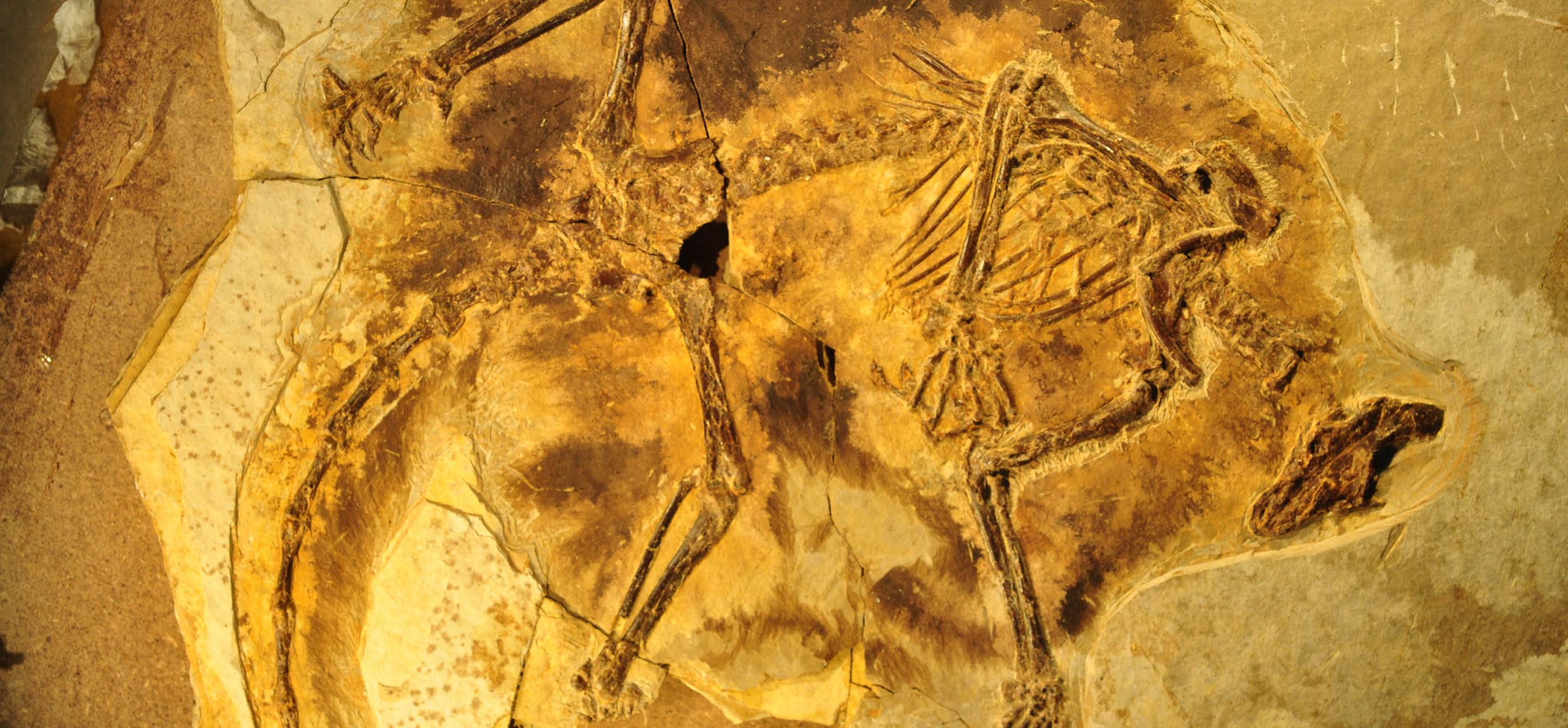
The fossils, Maiopatagium furculiferum (shown above) and Vilevolodon diplomylos, are now the oldest winged mammals known to science, part of an extinct lineage called the haramiyidans. (Photo courtesy Zhe-xi Luo)
Two newly discovered species bring humans closer to understanding our lineage.
No one bothered to clone mammals for Jurassic Park. Dinosaurs were the stars of the Mesozoic era, ruling uncontested until their mysterious, dramatic end. But two 160-million-year-old fossils unearthed in China reveal exciting action behind the scenes—suggesting that mammals hit their evolutionary stride much earlier than scientists previously realized.
The fossils, Maiopatagium furculiferum (shown above) and Vilevolodon diplomylos, are now the oldest winged mammals known to science, part of an extinct lineage called the haramiyidans. Maiopatagium—nine inches long, slightly larger than mouse-sized Vilevolodon—translates to “mother with skin membrane.” These prehistoric critters resembled modern-day flying squirrels, with their furry coats, long fingers, and fleshy parachute-like membranes. But they took flight long before the ancestors of any living relatives, which followed different branches of the family tree and developed wings independently around 100 million years later.
“It’s amazing that the aerial adaptations occurred so early in the history of mammals,” says David Grossnickle, a graduate student in the Committee on Evolutionary Biology and a member of professor Zhe-Xi Luo’s lab. “Not only did these fossils show exquisite fossilization of gliding membranes, their limb, hand, and foot proportion also suggests a new gliding locomotion and behavior.”
Mammals are far from the most biologically diverse class. They comprise an estimated 5,400 species, compared to 10,000 birds, 27,000 fish, and millions of insects. But mammals are rich in ecological diversity. From bats to manatees to giraffes, they have adapted to a much broader range of environments than other vertebrates.
“Our two new gliders are just a demonstration that this fundamental mammalian ecological diversity is actually a very interesting biological signature of our entire group, going from the very beginning of our entire history,” says Luo, professor in the Department of Organismal Biology and Anatomy at the University of Chicago. The Luo Lab focuses on the evolution of early mammals, with the help of a custom-made X-ray computed tomography scanner affectionately known as PaleoCT (unlike similar medical equipment, these X-rays are powerful enough to see through rock).
Luo, who has studied mammals since he was an undergraduate at China’s Nanjing University, coauthored two papers, both published in Nature this past August, on Maiopatagium and Vilevolodon with an international team of researchers from UChicago, the Beijing Museum of Natural History, and China’s Hebei Geo University. These studies add to a growing body of evidence suggesting that mammals evolved not in the wake of dinosaurs but alongside them.
Maiopatagium and Vilevolodon lived in the trees, above the jaws and claws of their reptilian contemporaries. Gliding also helped them reach seeds, fruits, and other elevated food sources likely suited to their dental anatomy. Wings like theirs are one of many biological innovations that enabled mammalian species to thrive around the globe.
After the Cretaceous–Paleogene extinction—the one that took out most of the dinosaurs—mammals proliferated, resulting in one of the most extensive fossil records available. The Maiopatagium and Vilevolodon fossils were exceptionally well preserved for their age, still showing outlines of skin, hair, and other soft tissue. But the process of studying ancient fossils remains delicate and time consuming.
Luo’s team used PaleoCT to build 3-D skeletal renderings of each glider fossil. Those renderings informed the illustrations and animations for Maiopatagium and Vilevolodon created by scientific illustrator and lab manager April Neander. “After CT scanning it takes thousands of hours to get a detailed morphology right,” Luo says.
To fill in details not preserved in the fossil record, researchers drew from available information and parallels to living relatives. Primitive mammals had less developed hearing than their descendants. “As a reflection of that, I didn’t make the external ear very big,” says Neander.
Scholarly interest in fossils is on the rise, driven in part by the need for physical evidence to corroborate research conducted at the molecular level. Fifteen other labs on campus use the Luo Lab’s equipment for their own research, from neurosurgeons to geophysicists.
In some ways human interest in other mammals is self-centered. (The fact that they’re cute doesn’t hurt. “You find fossils where they’re snuggled up with each other,” Neander says.) The origins of our distant-but-not-too-distant relatives may harbor clues about our own ancestry.
“Mammals are us,” Luo says. “Many of the biological traits that we came to associate with ourselves, like parental care, nursing of babies, our hair, the way we talk, the way we hear, the way we feed … can be mapped in the evolutionary record—that’s fossils—to give us an understanding of it.”
Despite the differences in our anatomies and our experiences, mammals share one thing in common: the hustle. Even our earliest ancestors displayed a relentless drive to adapt—to our environments, our neighbors, and our evolving circumstances. On this level at least, we can all relate.
